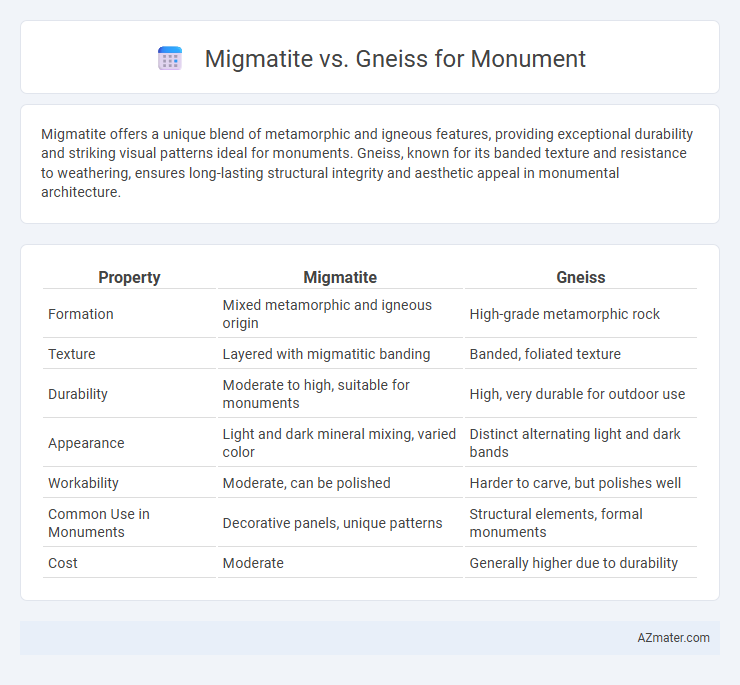Migmatite offers a unique blend of metamorphic and igneous features, providing exceptional durability and striking visual patterns ideal for monuments. Gneiss, known for its banded texture and resistance to weathering, ensures long-lasting structural integrity and aesthetic appeal in monumental architecture.
Table of Comparison
| Property | Migmatite | Gneiss |
|---|---|---|
| Formation | Mixed metamorphic and igneous origin | High-grade metamorphic rock |
| Texture | Layered with migmatitic banding | Banded, foliated texture |
| Durability | Moderate to high, suitable for monuments | High, very durable for outdoor use |
| Appearance | Light and dark mineral mixing, varied color | Distinct alternating light and dark bands |
| Workability | Moderate, can be polished | Harder to carve, but polishes well |
| Common Use in Monuments | Decorative panels, unique patterns | Structural elements, formal monuments |
| Cost | Moderate | Generally higher due to durability |
Introduction to Migmatite and Gneiss
Migmatite is a hybrid rock exhibiting characteristics of both metamorphic and igneous origin, formed through partial melting under extreme temperature and pressure conditions. Gneiss is a high-grade metamorphic rock distinguished by its distinct banding and foliation resulting from intense heat and directed pressure. Both rocks are valued in monument construction for their durability, unique textures, and striking visual patterns.
Geological Origins: Migmatite vs Gneiss
Migmatite forms through partial melting processes where igneous and metamorphic components intermingle, indicating high-grade metamorphism and localized melting within the earth's crust. Gneiss originates from high-grade metamorphism of pre-existing rocks such as granite or sedimentary layers, characterized by distinct banding caused by mineral segregation under intense pressure and temperature. The geological origin differences reflect migmatite's transitional nature between igneous and metamorphic rock, while gneiss represents metamorphic transformation without melting.
Physical Characteristics and Appearance
Migmatite exhibits a unique blend of igneous and metamorphic textures, characterized by its banded appearance with irregular, convoluted layers of light-colored granitic material interspersed with darker metamorphic bands. Gneiss displays well-defined, alternating foliated bands of light and dark minerals, creating a striking striped pattern with a coarse-grained texture. Both rocks show excellent durability and resistance to weathering, making them popular choices for monuments, but migmatite's intricate patterns offer a more dynamic aesthetic compared to gneiss's consistent banding.
Durability and Weather Resistance
Migmatite exhibits exceptional durability and superior weather resistance due to its combination of metamorphic and igneous characteristics, making it ideal for monuments exposed to harsh environmental conditions. Gneiss, with its distinctive banded texture and high quartz and feldspar content, also offers strong durability and resistance to weathering, but generally performs slightly less well than migmatite in freeze-thaw cycles and acid rain exposure. Both rocks resist erosion effectively, but migmatite's complex structure provides enhanced long-term stability for outdoor monumental applications.
Workability and Sculpting Potential
Migmatite offers moderate workability with its mixed metamorphic and igneous textures, allowing for detailed sculpting but requiring careful handling due to its variable hardness and potential for splitting. Gneiss provides superior workability for monuments, characterized by its distinct banding and consistent mineral composition, enabling precise carving and durable finished surfaces. Both materials are favored for monumental art, but gneiss's toughness and predictable fracture patterns make it the preferred choice for intricate sculptural work and long-lasting installations.
Aesthetic Appeal for Monuments
Migmatite offers a unique aesthetic appeal for monuments due to its striking blend of light and dark mineral bands, creating a visually dynamic and natural pattern that enhances architectural artistry. Gneiss is prized for its distinct foliation and consistent banding, providing a sophisticated, elegant appearance with strong structural integrity that suits monumental designs. The choice between migmatite and gneiss depends on desired visual contrast and texture, where migmatite emphasizes dramatic, irregular patterns, and gneiss offers refined, orderly layering.
Cost and Availability
Migmatite and gneiss differ significantly in cost and availability for monument construction; gneiss is generally more abundant and cost-effective due to its widespread natural deposits and consistent quality. Migmatite, formed through partial melting of metamorphic rock, tends to be rarer and more expensive, often commanding higher prices because of its unique banded appearance and complex formation process. When selecting materials, cost-efficiency and local availability make gneiss a preferred choice for large-scale monuments, while migmatite suits specialized projects demanding distinctive aesthetics.
Historical and Cultural References
Migmatite and gneiss have been historically significant in monumental architecture due to their durability and distinctive banding patterns. Gneiss, frequently used in ancient Egyptian and Scandinavian monuments, symbolizes strength and endurance in cultural heritage. Migmatite's unique fusion of metamorphic and igneous textures often represents transformation and resilience in indigenous and regional art forms.
Maintenance Requirements
Migmatite and gneiss both offer durable options for monuments, but their maintenance requirements differ due to their mineral compositions and structural properties. Migmatite, a hybrid rock with both igneous and metamorphic characteristics, can exhibit variable hardness and may require more frequent sealing to prevent weathering and staining, especially in outdoor settings. Gneiss, known for its distinct banding and greater resistance to abrasion and chemical weathering, typically demands less frequent maintenance and retains its aesthetic appeal longer under environmental stress.
Conclusion: Choosing the Right Stone for Monuments
Migmatite offers a unique blend of metamorphic and igneous characteristics, providing enhanced durability and a visually striking pattern ideal for monuments requiring both strength and aesthetic appeal. Gneiss features distinct banding and high resistance to weathering, making it a preferred choice for monuments in harsh environments due to its longevity and classic appearance. Selecting the right stone depends on the monument's exposure conditions and desired artistic effect, with migmatite favored for bold designs and gneiss for traditional, enduring structures.

Infographic: Migmatite vs Gneiss for Monument
 azmater.com
azmater.com